The town of Tall Afar lies west of Mosul. The area commanders of Tall Afar wanted the Navy SEALs from teams 5 and 8 to protect the voting booths for the upcoming Iraqi elections. The snipers had been so successful in Mosul that they hoped for a similar positive experience during one of the most important events in recent Iraqi history. Paul experienced the best two and a half weeks of his life in Tall Afar.
An American-held Iraqi hospital was one of the official voting stations. This particular area was a hot bed of insurgent activity and needed pacifying. The local
Commanders briefed the SEAL platoons on the insurgents’ training, tactics, and procedures. The SEALs, now well versed in their sniping operations, again used Strykers for the bait and switch operations that had served them so well in Mosul earlier. The snipers also set up unique shooting sites specific to the areas they had to cover. The overall battle space commander of Tall Afar had a great deal of confidence in the snipers and not only permitted them the use of the expensive Strykers, but in effect allowed them to do whatever they needed to accomplish the mission. It was of the utmost urgency to allow Iraqis the ability to live freely and vote during the election.
Navy SEALS occupying the 16th-century Ottoman castle of Tall Afar. The castle provided an ideal base of operations for SEAL snipers. (Authors' collections)
In the early hours of the combat operations, Paul witnessed one of the greatest shots he had ever seen taken by a fellow SEAL sniper. The “bad guys”119 were scouting the areas near the sniper hide-sites but could not pinpoint any American positions. Paul mentioned that these insurgents did not wear traditional local Arab clothes and Signal Intelligence (SIGNIT) indicated an impending attack. The three SEAL sniper teams were carefully monitoring the main supply route/road (MSR) when they spotted a man wearing a jacket way down the MSR.
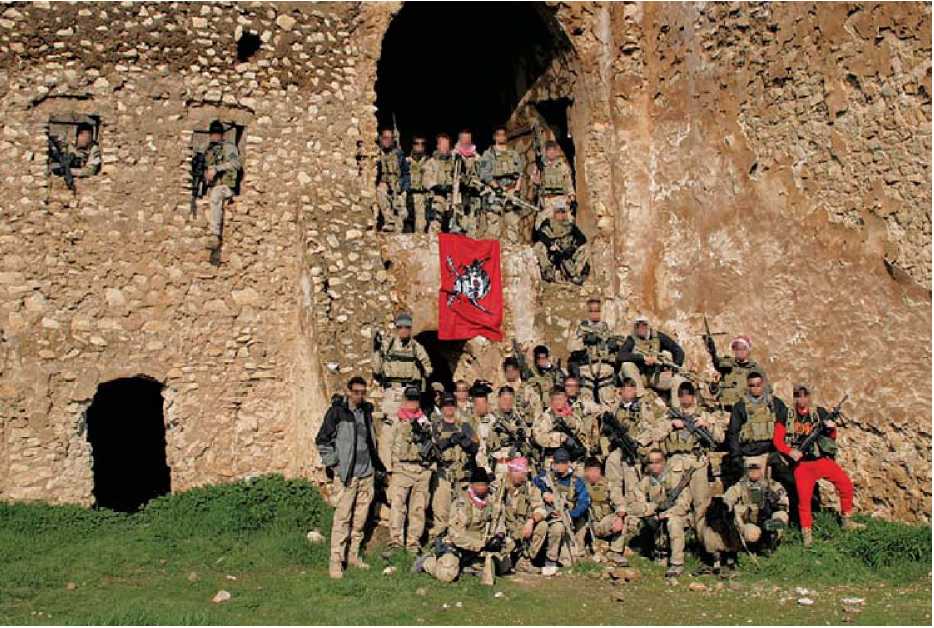
Sniper action in Tall Afar. (Authors' collections)
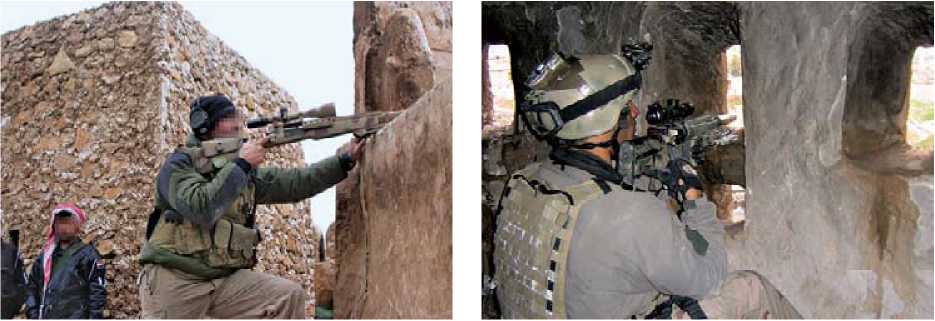
The SEALs knew from previous briefings that weapons were smuggled back and forth by individuals who hid them beneath their clothing. As luck had it, a wind picked up and revealed an AK underneath the man’s jacket. The engagement began when one sniper shot one round that struck the man in his leg, putting him down on the street. After a couple of follow-up shots the man was dead. No doubt the insurgents now knew that American snipers were in town. This shooting incident triggered multiple well-coordinated engagements by the insurgents and Paul ranged his shooter at a target of 997 yards. Paul’s sniper lit off a round and hit the Iraqi center chest and “laid him out like a fish.” The amazing thing was that the SEAL shooter had not attended sniper school. However, he was an Olympic-caliber match 22 shot, and he was probably the best shot from the West Coast teams. Part of the SEALs training also included an in-house, two-week, scout sniping program. ST-5 conducted many such informal training courses in an effort to improve their tactics and procedures.
The multiple sniping engagements lasted for over two weeks until the election finished. According to one SEAL, in Mosul and Tall Afar the SEALs had a 90-100 percent chance of contact when they left the gate. The four Purple Hearts won by SEALs in this time proved how dangerous their work was. Finally, the commander of ST-3, Commander Riley, pulled them out because he was worried that dead SEALs would be bad for his record and promotion.120 Two American Army soldiers and three Iraqi soldiers had been killed near the old castle of Tall Afar.
One interesting point was that the insurgents soon realized the significance Americans placed on body counts, so they would do their best not to leave dead bodies in the streets. Many times women and children would appear and the body and gun, sometimes on a string, disappeared. If anyone picked up a gun the SEALs shot them. Some Iraqis picked up flat cardboard and built a box
A US Navy SEAL sniper. (Authors' collections)
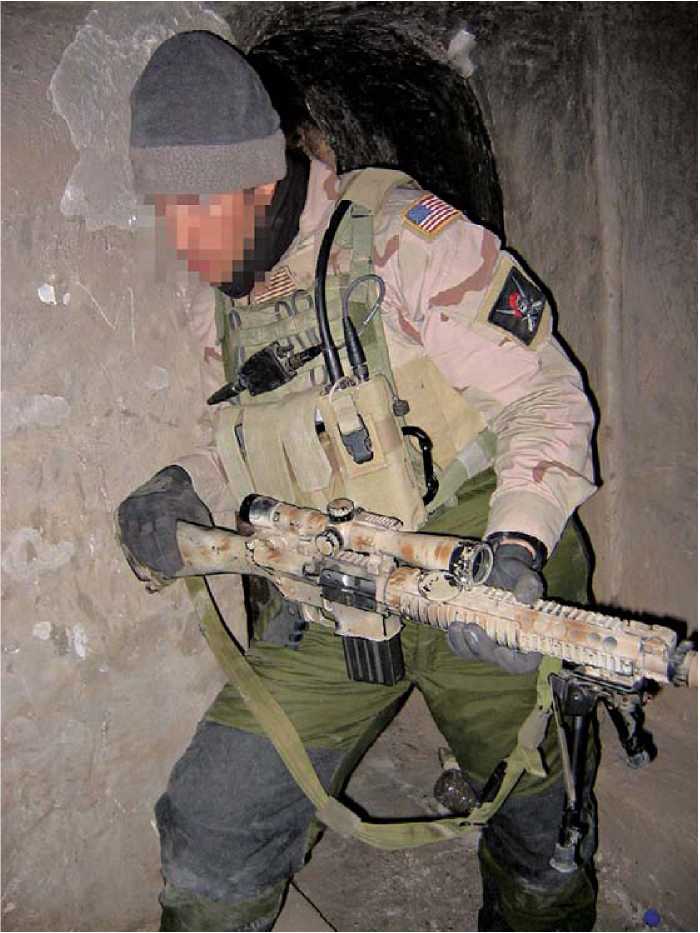
Around the weapon which they then surreptitiously carried. Some Iraqi women also cleaned the area as well and the snipers saw them carry new dirt to the battle area to cover bloodstains. The SEALs sent Strykers to take a look at those areas and, indeed, they often found bloodstains covered by new dirt. Other times some of those killed were not buried quickly. Those, the SEALs thought, were probably foreign fighters.
The Tall Afar Castle provided a great sniping and counter-sniping position. It was so well situated that the SEALs were able to hit any relief forces that wanted to rush into the areas the SEALs covered for the election. Local Iraqi police and several Strykers supported the position. By 0300 hours the SEALs had set up their fields of fire and the single best sniping position were the lavatories used by the 82d Airborne Division earlier in the war.
Navy SEAL platoon looking menacing at Tall Afar. (Authors' collections)
On one day, Paul was bored and threw a turd at his buddy just as a coordinated attack was launched on the castle. More than a dozen mortar rounds, RPG rockets, small-arms fire, and carefully aimed sniper shots hit the castle. Coolly, the American snipers found their targets. Many insurgents were dressed in black with white headbands and this made them easy to identify. Air assets tried to add to the insurgents’ death toll but some of the CAS support was just not precise enough. Nevertheless, the firefight lasted for six hours. The SEAL snipers learned a lot from trying to hit men sprinting at full speed at a distance of 600 to 1,100yds. Paul estimated that the SEALs hit one out of every six runners. Any insurgent who hesitated usually got hit. “He who hesitates, dies.”
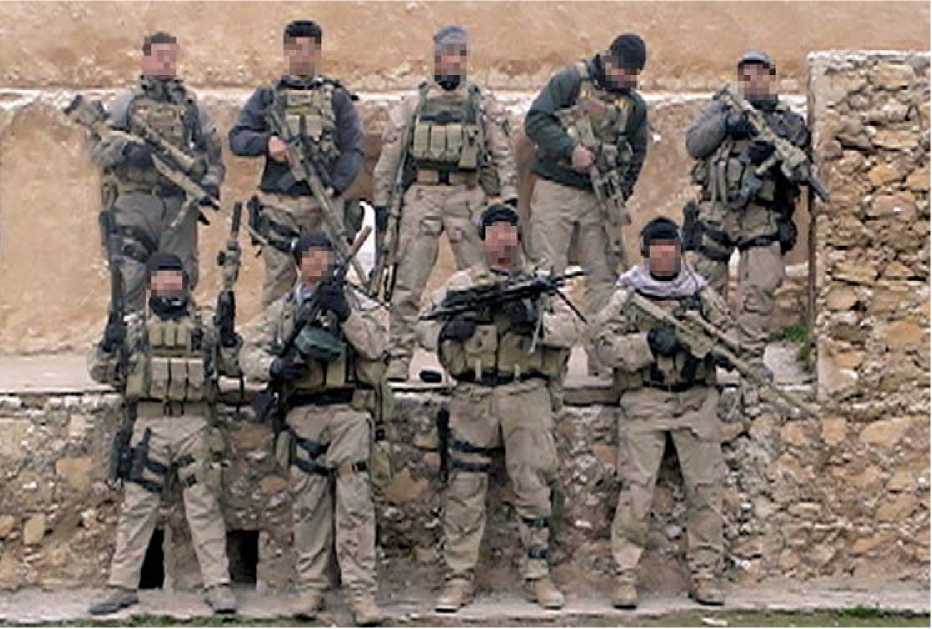
One particularly tough nut to crack was a well-disciplined sniper who turned out to be Syrian; the SEALs counter-sniped with him repeatedly. Counter-sniping required patience, a keen eye, and luck. It took three days to kill the Syrian sniper and it happened just as the SEALs’ mission was about to end. The enemy sniper was so good that a mannequin the SEALs used to draw fire had three head shots. The Syrian used an HK sniping rifle which the Americans ultimately recovered. Paul compared the sniping experiences to the German and Russian WWII snipers locked in mortal combat depicted in the film Enemy at the Gates.
Paul tried to draw the Syrian’s fire but could not get him to expose himself for even a split second. He was professional and disciplined, and throughout the day small-arms fire intermixed with sniper rounds. So it was tough to isolate the enemy sharpshooter.
The city of Tall Afar is catacombed with a medieval city beneath. Paul spotted children playing soccer, occasionally moving through the underground cave network. Finally, the SEALs figured out that the insurgents were using the network to maneuver into better positions unseen.
The Syrian must have had spotters. The SEAL snipers thought that there was one expert sniper with a support team composed of probably four to five men who helped spot and snipe as well. The Americans did have the advantage of superior technology. The Stryker had excellent optics to scan the areas but the
This dummy took three head shots in the SEALs' attempt to draw out enemy snipers. (Authors' collections)
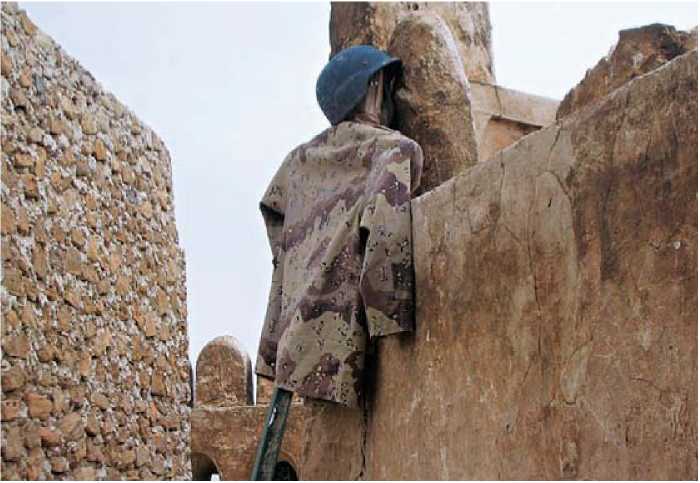
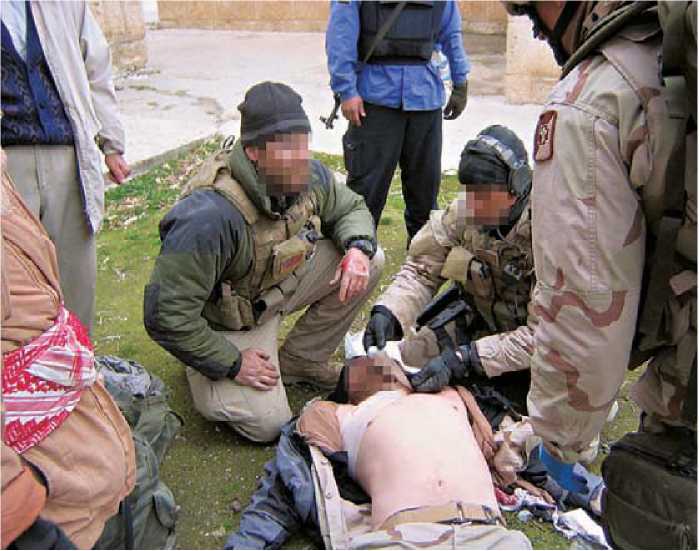
The SEALs in Tall Afar found insurgent snipers to be no slouches. This interpreter learned that the hard way. The bullet just clipped his shoulder, and took a clean slice out of him. (Authors' collections)
Syrian sniper was so good he shot out the optics. The SEALs knew he was close but could not get a precise location on him, only a general area. The snipers put out flank security to lock off particular areas.
SEALs used observation drills to locate the target. They scanned and shot anything suspicious but nothing came of it and it was getting late in the day. Paul looked for an edge. The Stryker commander would not risk another expensive optical system, so Paul thought of using the Iraqi police as bait. He placed them on the top ring of the castle’s battlements with orders for them just to shoot.
The day was ending. The mission had been a success. The Iraqis had voted, protected by a small but dedicated force of Americans. The SEALs started to wind down. A few of their snipers were on the walls alongside the Iraqi police. Several men kept shooting, hoping to catch the Syrian sniper trying to get a hit. Maybe he would drop his cover, take a risk to get a kill.
Paul spotted an interpreter exposed at an archer window on the battlement. The SEAL told him to get away from the window but shortly thereafter he got hit in the shoulder and the bullet hit an Iraqi police officer in the spine as well. The SEALs medically evacuated the wounded out of the castle. Finally, one SEAL sniper from ST-8, using the observation drills learned in sniper school, spotted the small movement of a brick at a house closest to the castle, followed by a shot.
Keeping a close eye on any activity on the streets. No effort was spared to protect voters in Tall Afar. (Authors' collections)
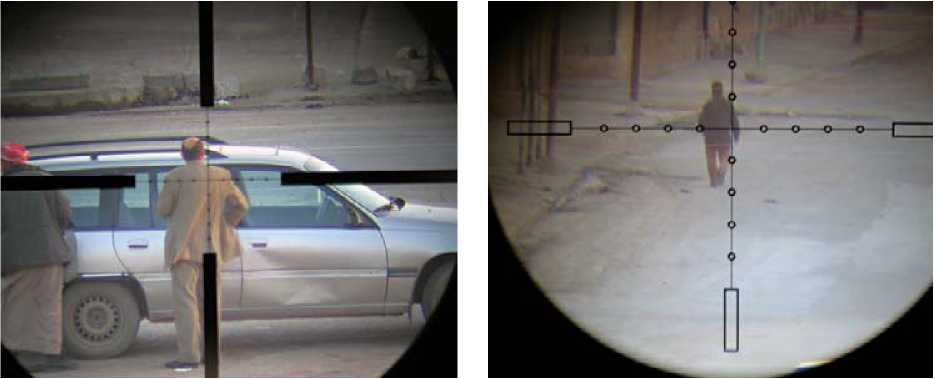
Some of the SEALs assaulted the building but could not find the exact location as more shots rang out. Then they found the place. It was a small false wall hidden inside the building. The spotter would pick out a target and the Syrian sniper would move the brick, fire his weapon, and place the brick back into its hole. Although there was no body, it seemed likely that one of the American snipers had hit the Syrian because the SEALs who assaulted the house found brain and other cerebral matter. Additionally and more importantly, they found the sniper’s rifle in an alley as a car sped off.
The Tall Afar mission was a great success. In a speech delivered at Cleveland on March 20, 2006, President George W. Bush referred specifically to Tall Afar as evidence of the new US strategy in Iraq:
The recent elections show us how Iraqis respond when they know they're safe. Tal Afar is the largest city in Western Nineveh Province. In the elections held in January 2005, of about 190,000 registered voters, only 32,000 people went to the polls. Only Fallujah had a lower participation rate. By the time of the October referendum on the constitution and the December elections, Iraqi and coalition forces had secured Tal Afar and surrounding areas. The number of registered voters rose to about 204,000-and more than 175,000 turned out to vote in each election, more than 85 percent of the eligible voters in Western Nineveh Province. These citizens turned out because they were determined to have a say in their nation's future, and they cast their ballots at polling stations that were guarded and secured by fellow Iraqis.
The confidence that has been restored to the people of Tal Afar is crucial to their efforts to rebuild their city. Immediately following the military operations, we helped the Iraqis set up humanitarian relief for the civilian population and by improving infrastructure from
The electric grid to sewer and water systems. With their city now more secure, the people of Tal Afar are beginning to rebuild a better future for themselves and their children.
The success of Tal Afar also shows how the three elements of our strategy in Iraq - political, security, and economic - depend on and reinforce one another. By working with local leaders to address community grievances, Iraqi and coalition forces helped build the political support needed to make the military operation a success. The military success against the terrorists helped give the citizens of Tal Afar security, and this allowed them to vote in the elections and begin to rebuild their city. And the economic rebuilding that is beginning to take place is giving Tal Afar residents a real stake in the success of a free Iraq. And as all this happens, the terrorists, those who offer nothing but destruction and death, are becoming marginalized.121
RAMADI
SEAL Death Dealers and Casualties
Ramadi lies in the Al Anbar province and is about 70 miles west of Iraq’s capital city, Baghdad. American commanders suspected Ramadi of being a staging area for terrorist activity because of its location and the fact that it hosts the main railway line into Syria. In June 2006, American forces assaulted the city in another brutal fight. The SEALs conducted numerous missions for the Marine and Army combat elements involved in the fighting. Kyle went to Ramadi on his third deployment to Iraq. He traveled out a week after the rest of Charlie Platoon, but “somehow the word did not get passed that I was coming in.”122 So he had to make his own way to Ramadi. Here he explains how he managed to get across Iraq:
The dummy in this picture was named after the Tom Hanks' “co-star" in the movie Cast Away, Volleyball Wilson. The head was used to draw enemy sniper fire. (Authors' collections)

So I hooked up with an SF guy, they got me to the helo pad. Then I hooked up with a Ranger who was going to Ramadi too. I was listening to people talk about what they shouldn’t be saying, like, I heard there was certain shit going on, that there was an enemy mortar team and all sorts of stuff. I was trying to catch a helo to Alisade Air Base, near the Syrian border, cause from there you can go anywhere. There was a general who was talking about that mortar team at Alisade. I walked up and said “Hey I need to go on this helo.” And he turned around and said, “So what makes you so important that some of my guys need to get bumped off?” I said, and I had all my guns and everything, “I’m a sniper and I’m supposed to go to Alisade and take out a mortar team.” Of course I was full of shit and I turned to my Ranger guy and said, “And this is another sniper, there’s two of us going out.” So he turns around and says “Here, these guys get the first two seats. Get to Alisade,” and then I told the Ranger, “Hey, come with me, we’re going to the CASH.”
The CASH (Combat Support Hospital) is the medical center. When Kyle and his Ranger friend arrived there, they found that the only helicopters flying into Ramadi were medevacs, so Kyle managed to persuade a Marine to let them be “medevaced to Ramadi,” as if they were returning to duty after being medevaced out. When he got to Ramadi, he went to Camp Ramadi and tried to link up with his platoon.
No fighting man wants to win this medal, but Purple Hearts are not unknown to SEALs. (Authors' collections)
Actually the platoon had taken off to Camp Corregidor which is on the east side of Ramadi, cause they were supposed to be, they were going to do an assault on Ramadi like they did on Fallujah. So everybody’s pulled over there, it was just me and two other team guys at Camp Ramadi. So I was pissed off, I was like shit, I just missed the whole thing. So I went and sat on a guard tower one day just thinking I would get the lay of the land, took a sniper rifle with me, I ended up getting two kills. And at this time no one had had any kills out there during this deployment. So they get the word at Corregidor and of course they go, “Oh fuck, Kyle is here.” But it worked out great, the assault ended up not getting approved so they all came back and then we just started doing sniper watches, or overwatches. And it was awesome at first ’cause the Army owned the main part of Ramadi and the north portions were owned by the Marines who we’d go to and say, “Hey, where’s your hottest spot?” And then they’d point it out and we’d say, “OK, we’re going in, will you come QRF us if we need it? ” At first they were like, “Um, I’m not taking a tank down there.” “Well, if we patrol 200yds will you come pick us up there?” “Yeah.” So we started doing that. And then we started having a lot of great success, and then the Army and the Marines both said, “Hey, we’ll fucking come get you. Y’all are doing awesome.” And then they started coming to us and saying, “Hey, will you go here, will you go here.” And we just had a great relationship with them. And, in fact, they decided they were going to start putting the COPs [Combat Out Posts] in Ramadi, and the first one was COP Falcon, and they came to us and said, “Hey,
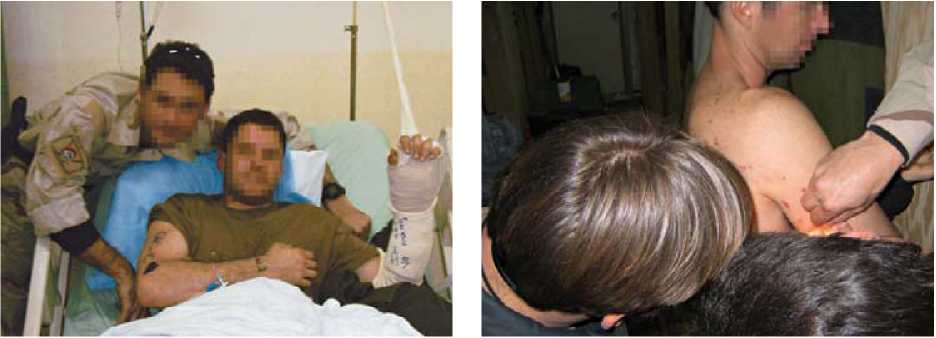
Left:
MRAP V-shaped hull designed to break away to survive the blast of an IED (MRAP vehicles feature a V-shaped hull, which deflects, rather than absorbs, the blast of an IED). The Marine EOD element in the vehicle survived. (Authors' collections)
Right:
An Iraqi counterpart poses with two Navy SEALs and an Iraqi family where someone had taken a shot at the SEALs. Shell casings were found and the family underwent gunpowder residue tests which proved that none of the family had fired a rifle. (Authors' collections)
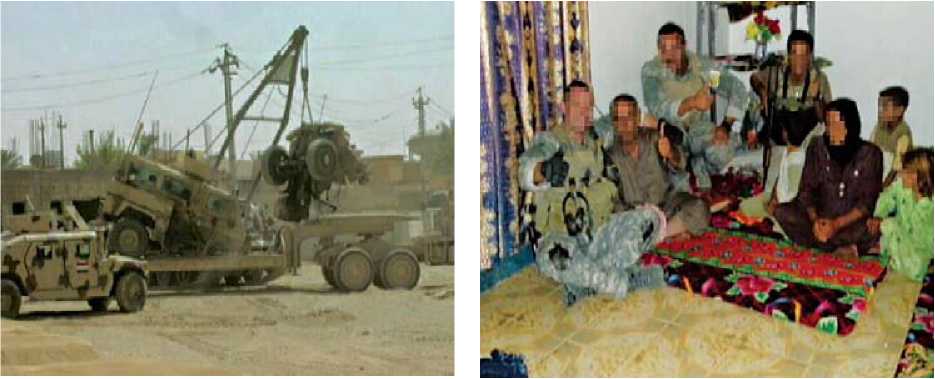
Do you want a part of this,” and we said, “yeah, we’ll go in before and secure it,” and they thought we were just fucking crazy. So we’d go in the night before and secure the place that they wanted to make their COP and they’ d come in early in the morning before the sun comes up and we’d do the high five and we’d bump off a couple of hundred yards to overwatch where they were building it up. They thought that was great and turned out to be a great success and no one at the COP got shot at.
Kyle said that “it started to be where the general out there said, you are not going to put a COP in, unless the SEALs are there. They have to go in first.” The platoon was working all over the city. They secured buildings for new COPs, then after the Marines had occupied the buildings, they would move out to give them sniper overwatch as they established their base:
We did the next one, was on the west side, right about 300-400yds from the river. I don’t even know if that was the Tigris, the Euphrates or what it was, but it’s that river right there by Ramadi on the west side. The Marines, the boat drivers, they’re the ones that dropped us off and those guys are better than the SBT guys. And they inserted us completely quiet. No one knew we were there, we took it down. The next day all of a sudden the whole town is surprised to see the Army rolling in to set up a COP, ’cause it had already been secured. So we set them up, that was on the west side, then we bumped in a little bit further east and set up another one, went up north, even went in for the Marines and put one in for them. It was a great, great deployment.
During the six-month deployment, the SEALs helped put in five or six COPs, but their mission was broader than just establishing COPs:
We would drive to COP Falcon, cause that was the only one you could really drive to, and then from there we would stage. There were a couple of houses in this complex, they gave us our own house, and we spray painted “SEAL House” all over it. They helped us build shelves and cots and everything to make it our home and they would lock it up for us so no one else could get in. And we’d stage out of there and do foot patrols into the city to do sniper overwatches and we would just pick where we wanted to go. And we’d try to find where the most lEDs [improvised explosive devices] were coming from and the most shots and we’d go set up there.
SEALs like to name their vehicles, and earlier names like Goat Rope did not catch on, so GI Joe came to the rescue. (Authors' collections)
We only caught a few guys setting up lEDs. The most of our kills were either guys maneuvering on the COP or shooting at us. ’Cause if we took a place that was occupied, the rest of the city knew about it by 9-10 o’clock and those people didn’t come outside. They got to know there’s Americans in there. But usually by 9.30 or so we’d take our first shot anyway, so then they would know that there’s snipers out here. So we’d get into usually around an hour-long firefight and then about five in the afternoon another firefight. It got to be where you could set your watch by it. You know you’re going to shoot here and you’re going to shoot again at this time.
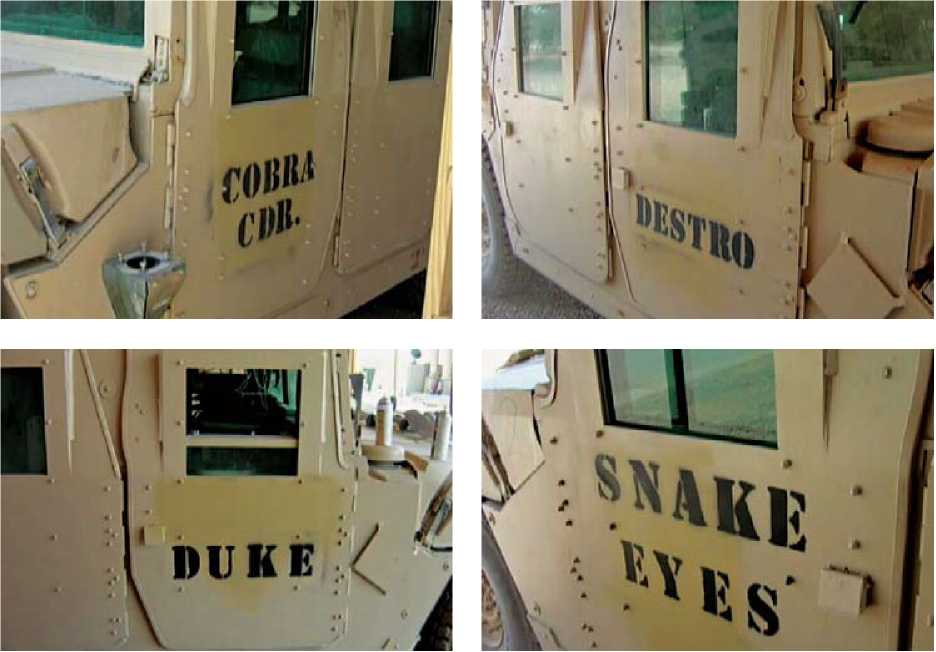
Left:
Camp Marc Lee. One SEAL wanted to feel the weight of the body armor used by EOD technicians. (Authors' collections)
Right:
During a firefight in Ramadi the NVDs were shot off the mount. This is one lucky SEAL. (Authors' collections)
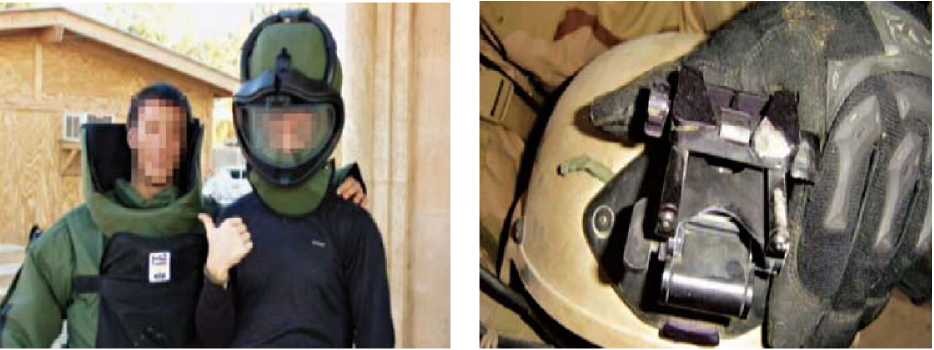




 World History
World History



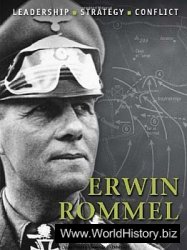
![Black Thursday [Illustrated Edition]](/uploads/posts/2015-05/1432470149_1431513568_003514b1_medium.jpeg)




